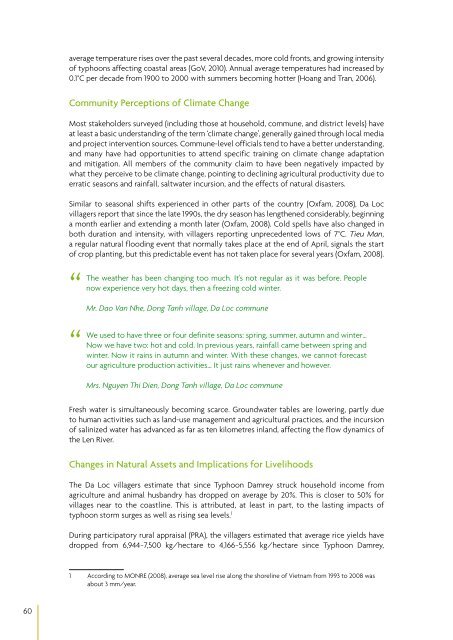Adaptation case studies.pdf - RECOFTC
Adaptation case studies.pdf - RECOFTC
Adaptation case studies.pdf - RECOFTC
You also want an ePaper? Increase the reach of your titles
YUMPU automatically turns print PDFs into web optimized ePapers that Google loves.
average temperature rises over the past several decades, more cold fronts, and growing intensityof typhoons affecting coastal areas (GoV, 2010). Annual average temperatures had increased by0.1°C per decade from 1900 to 2000 with summers becoming hotter (Hoang and Tran, 2006).Community Perceptions of Climate ChangeMost stakeholders surveyed (including those at household, commune, and district levels) haveat least a basic understanding of the term ‘climate change’, generally gained through local mediaand project intervention sources. Commune-level officials tend to have a better understanding,and many have had opportunities to attend specific training on climate change adaptationand mitigation. All members of the community claim to have been negatively impacted bywhat they perceive to be climate change, pointing to declining agricultural productivity due toerratic seasons and rainfall, saltwater incursion, and the effects of natural disasters.Similar to seasonal shifts experienced in other parts of the country (Oxfam, 2008), Da Locvillagers report that since the late 1990s, the dry season has lengthened considerably, beginninga month earlier and extending a month later (Oxfam, 2008). Cold spells have also changed inboth duration and intensity, with villagers reporting unprecedented lows of 7°C. Tieu Man,a regular natural flooding event that normally takes place at the end of April, signals the startof crop planting, but this predictable event has not taken place for several years (Oxfam, 2008).“Mr.The weather has been changing too much. It’s not regular as it was before. Peoplenow experience very hot days, then a freezing cold winter.Dao Van Nhe, Dong Tanh village, Da Loc commune“We used to have three or four definite seasons: spring, summer, autumn and winter…Now we have two: hot and cold. In previous years, rainfall came between spring andwinter. Now it rains in autumn and winter. With these changes, we cannot forecastour agriculture production activities… It just rains whenever and however.Mrs. Nguyen Thi Dien, Dong Tanh village, Da Loc communeFresh water is simultaneously becoming scarce. Groundwater tables are lowering, partly dueto human activities such as land-use management and agricultural practices, and the incursionof salinized water has advanced as far as ten kilometres inland, affecting the flow dynamics ofthe Len River.Changes in Natural Assets and Implications for LivelihoodsThe Da Loc villagers estimate that since Typhoon Damrey struck household income fromagriculture and animal husbandry has dropped on average by 20%. This is closer to 50% forvillages near to the coastline. This is attributed, at least in part, to the lasting impacts oftyphoon storm surges as well as rising sea levels. 1During participatory rural appraisal (PRA), the villagers estimated that average rice yields havedropped from 6,944−7,500 kg/hectare to 4,166−5,556 kg/hectare since Typhoon Damrey,1 According to MONRE (2008), average sea level rise along the shoreline of Vietnam from 1993 to 2008 wasabout 3 mm/year.60
















